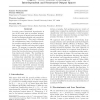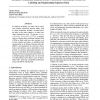ICML
2004
IEEE
16 years 1 months ago
2004
IEEE
Learning general functional dependencies is one of the main goals in machine learning. Recent progress in kernel-based methods has focused on designing flexible and powerful input...
85
Voted
ICML
2004
IEEE
16 years 1 months ago
2004
IEEE
Many NLP tasks rely on accurately estimating word dependency probabilities P(w1|w2), where the words w1 and w2 have a particular relationship (such as verb-object). Because of the...
112
Voted
ICML
2004
IEEE
16 years 1 months ago
2004
IEEE
Markov networks are extensively used to model complex sequential, spatial, and relational interactions in fields as diverse as image processing, natural language analysis, and bio...
90
Voted
ICML
2004
IEEE
16 years 1 months ago
2004
IEEE
The multiple-instance learning (MIL) model has been very successful in application areas such as drug discovery and content-based imageretrieval. Recently, a generalization of thi...
72
Voted
ICML
2004
IEEE
16 years 1 months ago
2004
IEEE
124
click to vote
ICML
2004
IEEE
16 years 1 months ago
2004
IEEE
In sequence modeling, we often wish to represent complex interaction between labels, such as when performing multiple, cascaded labeling tasks on the same sequence, or when longra...
105
click to vote
ICML
2004
IEEE
16 years 1 months ago
2004
IEEE
lative Novelty to Identify Useful Temporal Abstractions in Reinforcement Learning ?Ozg?ur S?im?sek ozgur@cs.umass.edu Andrew G. Barto barto@cs.umass.edu Department of Computer Scie...
ICML
2004
IEEE
16 years 1 months ago
2004
IEEE
We describe and analyze an online algorithm for supervised learning of pseudo-metrics. The algorithm receives pairs of instances and predicts their similarity according to a pseud...
124
click to vote
ICML
2004
IEEE
16 years 1 months ago
2004
IEEE
The problem of computing low rank approximations of matrices is considered. The novel aspect of our approach is that the low rank approximations are on a collection of matrices. W...
110
click to vote
ICML
2004
IEEE
16 years 1 months ago
2004
IEEE
Many difficult visual perception problems, like 3D human motion estimation, can be formulated in terms of inference using complex generative models, defined over high-dimensional ...



